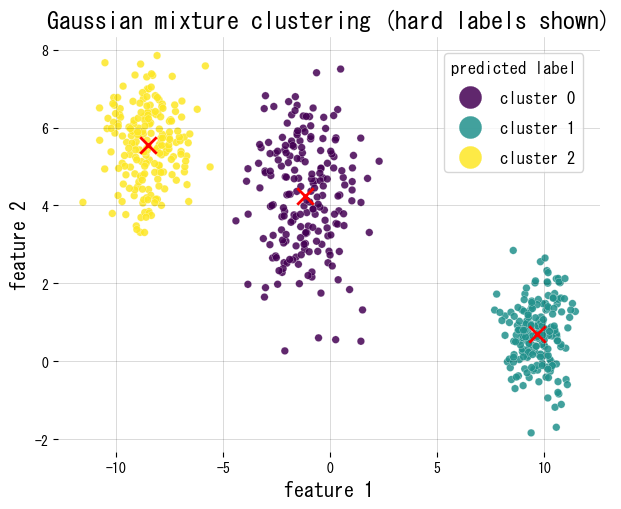- A Gaussian Mixture Model represents data as a weighted sum of multivariate normal components.
- It outputs a responsibility matrix that quantifies how strongly each component explains every sample.
- Parameters are estimated with the EM algorithm; covariance structures can be
full,tied,diag, orspherical. - Model selection typically combines information criteria (BIC/AIC) with multiple random initialisations for stability.
Intuition #
Assume the data arise from \(K\) Gaussian sources. Each component contributes a mean vector and covariance matrix, forming elliptical clusters. Unlike k-means, which makes a hard decision, GMMs provide soft assignments: for every sample \(x_i\) and component \(k\) we obtain \(\gamma_{ik}\), the probability that component \(k\) generated \(x_i\).
Mathematics #
The density of \(\mathbf{x}\) is
$$ p(\mathbf{x}) = \sum_{k=1}^{K} \pi_k , \mathcal{N}(\mathbf{x} \mid \boldsymbol{\mu}_k, \boldsymbol{\Sigma}_k), $$
with mixture weights \(\pi_k\) (non-negative and summing to 1). EM alternates:
- E-step: compute responsibilities \(\gamma_{ik}\). $$ \gamma_{ik} = \frac{\pi_k , \mathcal{N}(\mathbf{x}_i \mid \boldsymbol{\mu}_k, \boldsymbol{\Sigma}k)} {\sum{j=1}^K \pi_j , \mathcal{N}(\mathbf{x}_i \mid \boldsymbol{\mu}_j, \boldsymbol{\Sigma}_j)}. $$
- M-step: re-estimate \(\pi_k, \boldsymbol{\mu}_k, \boldsymbol{\Sigma}k\) using \(\gamma{ik}\) as weights.
The log-likelihood increases monotonically and converges to a local optimum.
Python walkthrough #
We fit a GMM to synthetic 2D blobs, plot the hard assignments, and report mixture weights and the responsibility matrix shape.
from __future__ import annotations
import matplotlib.pyplot as plt
import numpy as np
from numpy.typing import NDArray
from sklearn.datasets import make_blobs
from sklearn.mixture import GaussianMixture
def run_gmm_demo(
n_samples: int = 600,
n_components: int = 3,
cluster_std: list[float] | tuple[float, ...] = (1.0, 1.4, 0.8),
covariance_type: str = "full",
random_state: int = 7,
n_init: int = 8,
) -> dict[str, object]:
"""Fit a Gaussian mixture model and visualise hard labels with component centres."""
features, _ = make_blobs(
n_samples=n_samples,
centers=n_components,
cluster_std=cluster_std,
random_state=random_state,
)
gmm = GaussianMixture(
n_components=n_components,
covariance_type=covariance_type,
random_state=random_state,
n_init=n_init,
)
gmm.fit(features)
hard_labels = gmm.predict(features)
responsibilities = gmm.predict_proba(features)
log_likelihood = float(gmm.score(features))
weights = gmm.weights_
fig, ax = plt.subplots(figsize=(6.2, 5.2))
scatter = ax.scatter(
features[:, 0],
features[:, 1],
c=hard_labels,
cmap="viridis",
s=30,
edgecolor="white",
linewidth=0.2,
alpha=0.85,
)
ax.scatter(
gmm.means_[:, 0],
gmm.means_[:, 1],
marker="x",
c="red",
s=140,
linewidth=2.0,
label="Component centre",
)
ax.set_title("Gaussian mixture clustering (hard labels shown)")
ax.set_xlabel("feature 1")
ax.set_ylabel("feature 2")
ax.grid(alpha=0.2)
handles, _ = scatter.legend_elements()
labels = [f"cluster {idx}" for idx in range(n_components)]
ax.legend(handles, labels, title="predicted label", loc="upper right")
fig.tight_layout()
plt.show()
return {
"log_likelihood": log_likelihood,
"weights": weights.tolist(),
"responsibilities_shape": responsibilities.shape,
}
metrics = run_gmm_demo()
print(f"log-likelihood: {metrics['log_likelihood']:.3f}")
print("mixture weights:", metrics["weights"])
print("responsibility matrix shape:", metrics["responsibilities_shape"])

References #
- Bishop, C. M. (2006). Pattern Recognition and Machine Learning. Springer.
- Dempster, A. P., Laird, N. M., & Rubin, D. B. (1977). Maximum Likelihood from Incomplete Data via the EM Algorithm. Journal of the Royal Statistical Society, Series B.
- scikit-learn developers. (2024). Gaussian Mixture Models. https://scikit-learn.org/stable/modules/mixture.html